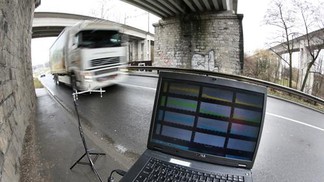Jan 19 2013
An EPFL doctoral student has designed a microphone-based system that functions as an automatic road traffic sensor. The technology can determine not just how much traffic there is, but also how fast vehicles are going and even their size. It has already sparked an interest in the Swiss towns of Sion and Martigny.
 Dual microphone system
Dual microphone system
Traffic noise isn’t just noise. It can also be a veritable data mine, as Patrick Marmaroli has shown. The Electromagnetics and Acoustics Lab (LEMA) PhD student has designed a dual microphone system that uses the sound produced when tires roll over pavement to determine traffic volume. The system can also track a vehicle’s speed and even determine its approximate size (i.e., whether a passing vehicle is a station wagon, compact, truck, etc). This information can then be used to provide traffic or air-pollution bulletins, and can also help engineers to better plan future road-building. “Currently, several different types of instrument are needed to obtain all of this information: a sound engineer who wants to know the number, speed and size of passing vehicles has to make not just sound measurements with a somometer, but also other measurements, using things like radar, video cameras, or pneumatic tubes,” says Marmaroli. “Then, all the data needs to be synchronized, which is expensive and time-consuming, given its heterogeneity. Our idea is to replace all of that with just one device that provides all the data synchronously and in a single format.”
A simple method based on complex algorithms
The system is light and has a small footprint. It is composed of two microphones placed a set distance from each other and a computer that runs a complex algorithm. “The first tests were done with a PC, but a smaller device could be used in the future,” says Marmaroli. The recording zone is only a few meters wide, and sound is recorded for about 4 seconds per vehicle. Each vehicle is detected and followed in real time, and its speed is estimated. It is also possible to determine the wheelbase (i.e., how much space there is between the axles), which provides information on what size the vehicle is. The sound is then mapped onto an image, with a slope whose steepness depends on the speed.
Filtering background noise
To optimize vehicle detection and monitoring, Marmaroli employs an acoustic tracking approach. It is based on a “smart” algorithm that uses probability and some basic assumptions to filter out background noise and focus on the traffic. Background noises such as pedestrians, planes, or even a tractor in the fields near the road are ignored by the algorithm, in contrast to traditional sonometers, which don’t filter out background noise. In order to “select” the right sounds, the system’s algorithm assumes, for example, that a car heading in one direction at 80 km/h isn’t going to stop on a dime and speed off in the other direction at 80 km/h. It instead works from the assumption that the second track is another car, on the other side of the road, and doesn’t take account of it in its tracking of the first vehicle. In this way, the system can analyze several vehicles in real time without mixing them up.
Size and speed
Because there are two microphones in the array, it is also possible to determine the speed of traffic and the size of individual vehicles. Sound from the tires hits one microphone before the other, and this time-gap changes as the vehicle moves along. The system uses a Monte Carlo method to sequentially analyze changes in the time gap, thereby determining each vehicle’s position and speed.The audio analysis of each microphone is so precise that it is even possible to calculate the distance between the front and the rear tyres of each vehicle, with a margin of error of about 30cm. “30 cm is less than the width of a tire,” notes Marmaroli.
Soon to be implemented in Swiss cities?
The first tests of this groundbreaking traffic sensor system were conducted around the EPFL campus. Two Swiss cities, Sion and Martigny, may be interested in using the technology, and negotiations aiming to find financing and continue the project are underway. “The system could eventually be used in other areas, such as air traffic, train traffic or industrial metrology,” says Marmaroli. For the moment, the aspiring PhD candidate will be defending his thesis on 15 February 2013.
The following have collaborated in the methodology:
Dr Xavier Falourd (ex-LEMA, EPFL)
Dr Jean-Marc Odobez (IDIAP, Martigny)
Dr Mikael Carmona (CEA-LET, Grenoble)
Dr François Aballéa (AER, Lausanne)
The thesis has been co-supervised by Dr. Hervé Lissek and Prof. Juan Mosig